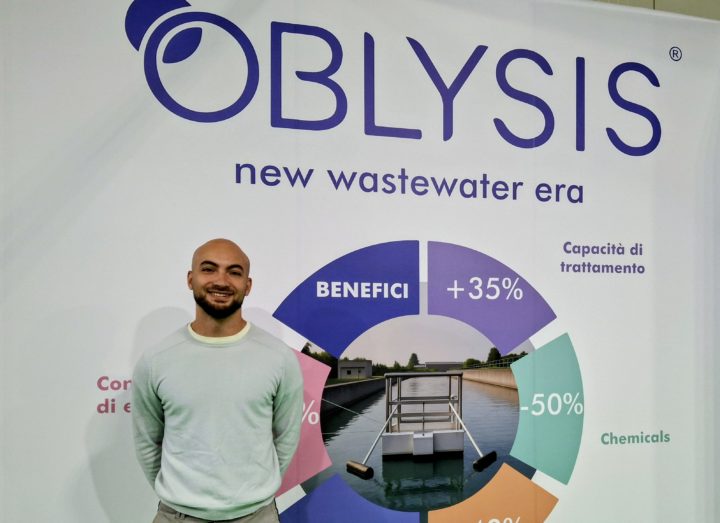In wastewater treatment, meaningful innovation is often buried under concrete involving costly retrofits, structural overhauls, or new builds. But a quietly growing Italian company is proving that smarter systems don’t have to be heavier ones. In fact, they may just float.
Text and photo: Mia Heiskanen for Maintworld magazine
At Ecomondo 2025, Ludovico Sanna, manager of an environmental tech firm, walked through an innovation that could rewrite the rules of biological wastewater treatment: a patented floating device paired with adaptive software, that turns conventionally activated sludge into a hybrid granular system without any structural changes to the plant.
-We don’t change the tanks, dig or rebuild. We just place our device into the reactor and from there, the system transforms itself, Sanna explained
The system acts directly within oxidation tanks or biological reactors, floating in the heart of the treatment process. There, it promotes the natural formation of hybrid granular biomass with a denser, more stable structure than conventional flocculant sludge. This results in:
- Better settling characteristics
- Increased biological capacity
- Optimized nutrient removal
- Lower energy consumption
- Reduced sludge production
- Decreased chemical use
It’s a self-improving process and that’s where the software comes in. While the hardware supports biological restructuring, the advanced control software actively manages the plant’s aeration, recirculation, and mixing systems, adjusting them in real time based on:
- Flow rate
- Organic and nutrient load
- Environmental and seasonal variations
The software doesn’t just automate; it adapts, Sanna explained. It optimizes performance every minute, without waiting for someone to change settings manually.
Installation is deliberately simple. A crane truck lowers the device into the tank; standard control cables are connected to blowers, pumps, and mixers. That’s it. There are no process interruptions. No reengineering of tanks or clarifiers. The only infrastructure added is intelligence in both hardware and code.
According to Sanna, the results are rapid. Plants see measurable energy reductions within days. Sludge production, a more complex, longer-cycle metric typically shows a marked decrease within one month, with full annual impact visible after a year.
-It’s one of the rare technologies where you don’t have to wait years to see payback. The efficiency gains show up fast.
Real-World Application. Since 2020, the system has been installed at more than a dozen facilities from Italy to Spain to the Caribbean treating populations from 220,000 to 500,000 equivalent inhabitants. Despite the system’s relative youth, results have drawn global attention, with incoming requests from utilities and municipalities in Ukraine, Hungary, Lebanon, Libya, and beyond.
-The performance comes from the synergy between the granular biomass and the advanced operational strategy. It’s not just about a device. It’s how biology and software evolve together.
Oblysis has been designed for any plant using activated sludge including both civil and industrial facilities. It doesn’t require a specific plant layout, size, or manufacturer making it compatible across a wide range of infrastructures.
Honest Tech. In an era where every vendor claims AI, Sanna is refreshingly candid: the current version doesn’t use artificial intelligence, yet. But that’s intentional.
-Right now, our system uses high-level adaptive control, not AI. We’ve tested sites that used AI-based systems and we outperformed them. It’s more important that it works than that it trends.
Plans for AI integration is on the roadmap, but with a focus on on-site safety, cybersecurity, and data reliability. When AI does arrive, it will be implemented carefully likely as a locally hosted system with offline model updates to ensure plant networks stay protected.
Born from a Dream. The story of this innovation did not start in a lab or a university. It started with a dream. The inventor woke up, visited a hardware store, and began prototyping in a biological tank. A week later, something unexpected happened: sludge behavior shifted. Settling improved. The experiment turned into an idea. The idea became a company. And now, that company is scaling a no-dig, no-disruption wastewater upgrade platform across multiple countries.
-We want this to be the standard. Why rebuild a plant if you can transform it from the inside?
____________________________________________________________
The Takeaway for Maintenance and Operations Teams
For industrial and municipal wastewater teams, this system offers less to maintain, more to gain and no structural overhaul required
Operations remain uninterrupted. Maintenance becomes remote. And plant performance improves without changing the footprint. In an industry where infrastructure is often too expensive to replace, a smart, biological retrofit offers a practical alternative.


